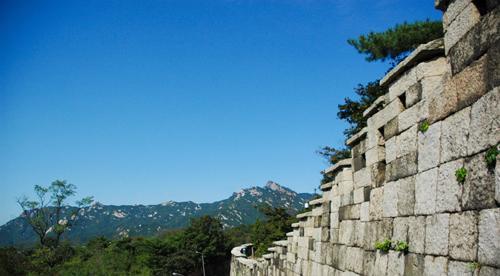One of the best ways to get a bird’s eye view of Seoul is to climb the Seoul Fortress Wall that encircles the sprawling metropolis teeming with modern skyscrapers ― and culture and heritage.
The view of Seoul from any vantage point on the stone wall is just fantastic and breath-taking. From the city center, it’s remarkably easy to access, all within an hour of hiking.
The 18.7-kilometer-long wall connects the city’s four encompassing mountains ― Inwang (338 meters), Bukak (342 meters), Nak (262 meters) and Nam (262 meters) ― and is joined by eight gates, four small and four main.
The view of Seoul from any vantage point on the stone wall is just fantastic and breath-taking. From the city center, it’s remarkably easy to access, all within an hour of hiking.
The 18.7-kilometer-long wall connects the city’s four encompassing mountains ― Inwang (338 meters), Bukak (342 meters), Nak (262 meters) and Nam (262 meters) ― and is joined by eight gates, four small and four main.

Each of the main entrances ― Sukjeongmun, Heunginjimun, Sungryemun and Donuimun ― denote the four virtues of Confucianism: North (“In” for generosity), South (“Ui” for righteousness), East (“Ye” for politeness) and West (“Ji” for wisdom), respectively. It is welcomed that all who hike the area must respect and abide by these principles.
There are four hiking courses that circle the area around each of the four main gates and require special permits in order to do so: Sukjeongmun (G course), Heunginjimun (A course), Sungryemun (C course) and Donuimun (D course).
Once hikers have completed all courses they are given a commemorative badge. All entry points except Sungryemun Gate distribute the badges.
The G course takes roughly 90 minutes and stretches an unforgiving two kilometers from Changuimun to Sukjeongmun. Visitors much first submit identification at Malbawi Information Center, located behind the presidential office, Cheong Wa Dae, on Mount Bugak, where they are then presented with a pass which must be worn at all times on the hiking trail.
Photos may only be taken at specified points along the path.
This point of entry is significant for two reasons. Firstly, it is where Changuimun is located, and secondly, it was the scene of one of the country’s more famous acts of aggression from North Korea.
The imposing granite archway of Changuimun Gate was built in 1396 and served as the main gateway linking the city to the north.
The wooden gatehouse above was burned down during the Imjin War (Japanese occupation of Korea) in 1592 and was later rebuilt in 1740. It remains the oldest of all four small gates and the starting point for the Seoul Fortress Wall stamp tour.
The statue of police Superintendent General Choi Gyu-sik near the entrance from the bus stop paints a stark reminder of an attack that almost led to the assassination of the president.
On Jan. 21, 1968, the head of Jongno Police Station in central Seoul received a secret report revealing a 31-member North Korean commando unit was moving in to launch an attack on Cheong Wa Dae.
As he and his men chased after the commando unit, the pursuit finally led to a stand-off and the police chief was shot. He died shortly afterwards from his injuries, but not without successfully having prevented the attack from taking place.
Both he and his assistant inspector, Jung Jong-su, died in the raid. A bronze statue and memorial monument have been erected to commemorate the two patriots on the Jahamun Pass overlooking the road to Cheong Wa Dae.
There are still traces from the shootings along parts of the hiking trail; holes can be found here and there from stray bullets that were fired in battles. Rusted barbed wire still snakes up much of exterior walling. Guarding posts where South Korean soldiers huddled and kept watch for approaching North Koreans are still present. Those guards have now been replaced by much younger soldiers that prevent visitors from taking photographs.
King Taejo, founder of the Joseon Dynasty (1392-1910), originally built the wall as a means of securing the city. The wall was originally built to withstand pressures from the outside and to seal in the city from oppressive forces. Yet, much of the architecture was later destroyed during the Japanese colonial period (1910-1945) and the Korean War (1950-1953).
In 1899, segments of the wall were demolished to make way for a rail system to transport goods and supplies. Seodaemun and Cheongnyangni Station were the first to see part of the demolition, and then a year later, Namdaemun.
The Seoul Metropolitan Government announced plans recently to restore the 615-year-old Seoul Fortress in its entirety to its former glory by 2014. The project will link together the city’s four gates and surrounding mountains.
To date, the city has restored 12.2 kilometers of the wall to its original form. The new plan will also include new trekking courses and several other tourist attractions.
City officials are seeking to include Seoul Fortress on UNESCO’s World Heritage list in 2015.
(Yonhap News)








![[Kim Seong-kon] Democracy and the future of South Korea](http://res.heraldm.com/phpwas/restmb_idxmake.php?idx=644&simg=/content/image/2024/04/16/20240416050802_0.jpg&u=)







![[KH Explains] Hyundai's full hybrid edge to pay off amid slow transition to pure EVs](http://res.heraldm.com/phpwas/restmb_idxmake.php?idx=652&simg=/content/image/2024/04/18/20240418050645_0.jpg&u=20240418181020)

![[Today’s K-pop] Zico drops snippet of collaboration with Jennie](http://res.heraldm.com/phpwas/restmb_idxmake.php?idx=642&simg=/content/image/2024/04/18/20240418050702_0.jpg&u=)